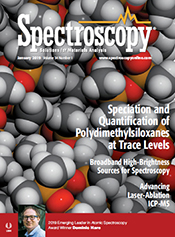In our January Issue:
COLUMNS
IR Spectral Interpretation Workshop
Organic Nitrogen Compounds, Part I: Introduction
Brian C. Smith
So far, we have restricted our discussion to organic functional groups that contain carbon, hydrogen, and oxygen, with past columns addressing the theory of infrared spectral interpretation of C-H bonds, C-O bonds, and the C=O functional group. We now turn our attention to interpretation involving organic nitrogen compounds.
Read more »
|
ADVERTISEMENT
Discover the Latest Advances in ICP-OES and ICP-MS Techniques
Tuesday, February 19, 2019 at 11am EST | 8am PST | 4pm GMT | 5pm CET
 Register now Register now |
Lasers and Optics Interface
Broadband High-Brightness Sources for Spectroscopy
Steve Buckley
In the near past, discharge lamps, dye lasers, and optical parametric oscillators were the only useful sources for spectroscopy. New broadband sources, such as supercontinuum lasers, laser-driven plasma sources, and high-brightness light-emitting diodes (LEDs), are now available. We look at what these options offer for spectroscopy.
Read more »
|
ADVERTISEMENT
Re-think Quantitative Analysis: Solutions for Challenging Measurements
Thursday, February 7, 2019 at 1pm EST | 12pm CST | 10am PST
 Register now Register now |
SPECTROSCOPY SPOTLIGHT
Advancing Laser-Ablation ICP-MS
Laura Bush
Jorge Pisonero of the University of Oviedo studies the performance of the laser ablation
process in laser ablation–inductively coupled plasma—mass spectrometry, examining aspects such as the morphology of the craters created during sampling and the role of laser fluence. He also studies the effect of these factors in specific applications of LA-ICP-MS. He recently spoke to us about this work.
Read more »
|
ADVERTISEMENT
The Role of Raman Spectroscopy in the QA/QC Laboratory
On Demand
 Learn more Learn more |
Feature
The 2019 Emerging Leader in Atomic Spectroscopy Award
Jerome Workman, Jr.
This year's Emerging Leader in Atomic Spectroscopy, Dominic Hare, is a forerunner in developing laser ablation–inductively coupled plasma–mass spectrometry methods for in situ analysis of trace elements in tissue to investigate the presence of biometals related to neurodegenerative diseases.
Read more »
|
Peer-Reviewed Article
SEC–ICP-OES Hyphenation: Speciation and Quantification of Polydimethylsiloxanes at Trace Levels
Kerstin Vogel, Antje Wegener, Matthias Pursch, Peter Luschas, and Marc Wiesmann
Polydimethylsiloxane (PDMS) compounds are ubiquitous; thus it is challenging to develop analytical methods that ensure their absence. A newly developed method combining size-exclusion chromatography with inductively coupled plasma–optical emission spectroscopy makes it possible to quantify ultratrace levels of PDMS in volatile and nonvolatile organic solvents. A complete range of molecular weights can also be distinguished with this approach.
Read more »
|
|

|
 |
Download the
issues: |
 |
 |
| |
| ON DEMAND WEBCASTS |
SERS Based Raman Module: Technology Overview including examples for Pharmaceutical and Law Enforcement Applications
Learn More » |
Single Cell Mass Spectrometry: An Emerging Technique for Metabolomic and Metal Content Analysis of Single Cells
Learn More » |
Environmental and Agricultural Applications of CESI-MS: Overcoming the Challenges of Quantifying Highly Polar Amines
Learn More » |
|
If you would like to submit an article to Spectroscopy, contact Laura Bush, Editorial Director - Laura.Bush@ubm.com
Spectroscopy is free to qualified subscribers. To subscribe, click here.
Click here to contact the Spectroscopy sales team. |

